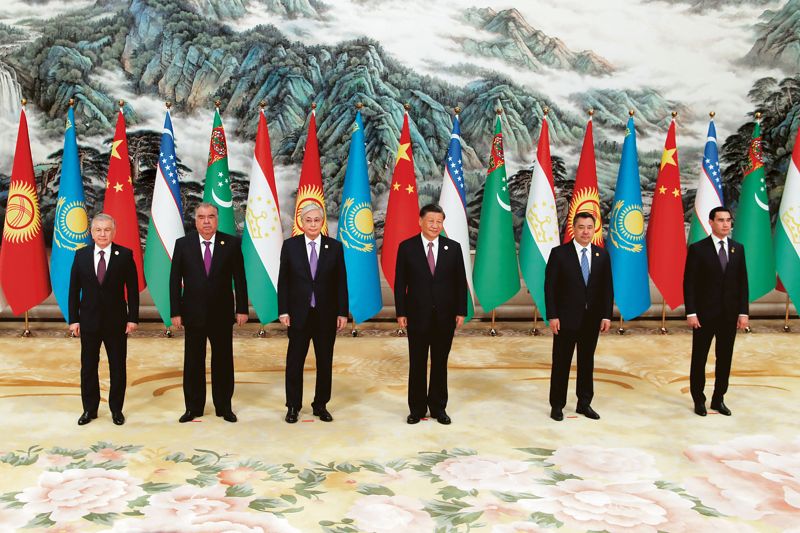President Xi Jinping challenges G7 dominance with Xian summit
LAST week, even as the Group of Seven (G7) countries focused on ways to contain China, Beijing worked to consolidate its already substantial influence in Central Asia through a summit convened in the ancient capital of Xian. The show of support that the Central Asian leaders gave Xi Jinping served to contrast with the negative image of China’s use of coercive diplomacy that was projected at the Hiroshima summit.
China has not wasted much time in taking advantage of Russia’s self-imposed predicament in Ukraine. This is precisely what President Vladimir Putin was worried about when he made his first foreign visit in June 2022, months after the start of the Ukraine war, to Tajikistan and Turkmenistan and participated in the sixth Caspian Summit along with the Presidents of Iran, Kazakhstan, Azerbaijan and Turkmenistan. At the time, though, Putin seemed concerned over the US efforts to move into the region. Earlier this year, US Secretary of State Antony Blinken visited Kazakhstan and convened a meeting of Central Asian foreign ministers. Now, even as Russia is pouring all its resources into the war in Ukraine, China is making its moves.
Central Asia borders China’s trouble province of Xinjiang. But it is also an important overland source of its energy supplies and has emerged as a gateway for overland trade with Europe. China’s trade with five Central Asian countries is booming; it reached $70 billion in 2022 and its investments there totalled some $15 billion. Kazakhstan accounted for $31 billion of the trade, while Kyrgyzstan came next with $15.5 billion, followed by Turkmenistan ($11.2 billion), Uzbekistan ($9.8 billion) and Tajikistan ($2 billion).
There is a special significance, too, of the fact that whereas earlier cooperation was bilateral or multilateral under the auspices of the Shanghai Cooperation Organisation (SCO), now it has been brought under a new minilateral involving China and the region.
Speaking at the end of the summit on Friday, Xi outlined a grand plan for the development of Central Asia, one that would involve building infrastructure and boosting trade. Towards that end, he announced $3.8 billion for financial support and grants. While he spoke of deepening connectivity, he did not quite say that China would support the development of the trans-Caspian international transportation corridor which would effectively bypass Russia. China is also pressing for the construction of the 523-km Kyrgyzstan-Uzbekistan-China railway that would go onwards to Turkiye and avoid Russia.
Xi’s four-point vision for a shared future of China and Central Asia included the notion of ‘universal security’, which called for the need to stand firm against external attempts to interfere in domestic affairs of regional countries. According to Xinhua, “Xi stressed that China is ready to help Central Asian countries improve their law enforcement, security and defence capacity building in an effort to safeguard regional peace.”
China has been very careful in its footing in Central Asia so as not to arouse Russian suspicions. It has not challenged the Russia-led Eurasian Economic Union that integrates several of the Central Asian and Caspian republics to Russia in a single market.
So, when it comes to security, the Chinese speak more about internal security and surveillance. As of now, the countries of the region are covered by the Russian-led Collective Security Treaty Organisation (CSTO) and Moscow maintains large bases on the outskirts of Dushanbe, Tajikistan and Kyrgyzstan. Observers have noted that while Russia is the dominant power and responsible for the security under the CSTO, it failed to deal effectively with the Kyrgyz-Tajik border skirmishes last year. Waning Russian influence is evident from the fact that none of the Central Asian nations have backed the Russian invasion of Ukraine, though they did abstain from a UNGA vote to condemn the invasion earlier this year. Kazakhstan provided sanctuary to thousands of Russians fleeing military service in 2022 and its President has put himself forward as a mediator to resolve the conflict.
The Chinese have financed the construction of an outpost for a special forces unit of the Tajikistan police at the Tajik-Afghan border in the Pamir mountains. However, the Tajiks made it clear that no Chinese troops will be stationed at the facility. Concerns over Xinjiang would suggest that Beijing would be keen to enter into a formal security cooperation with the Central Asian nations and revive the drills involving their People’s Armed Police.
It is not as though the Chinese moves are new or surprising. Central Asia neighbours China’s restive Xinjiang province. Kazakhstan, Kyrgyzstan and Tajikistan have land borders with China. The region has been a significant focus of the Belt & Road Initiative (BRI) and is a major supplier of oil and gas to China through a network involving three pipelines (the fourth is under construction). Indeed, it was in Kazakhstan that Xi had announced the BRI in 2013.
Since 2011, the China-Europe Railway Express has been running freight trains through a network of railways across Eurasia to various European destinations. In 2021 alone, over 15,000 trains transported 1.46 million shipping containers to Europe.
But the Ukraine war has posed issues over the northern route since the EU/US sanctions list includes the Russian Railways. BMW and Audi have suspended shipments by train to China and international shippers such as Maersk and DHL have halted their railway business.
Between the fiasco of the US pullout from Afghanistan and Putin distracted by his disastrous Ukraine venture, China is allowing the gravitational flow to work in its favour and there is little doubt that its influence in Central Asia will continue to grow significantly.
Source : The Tribune


